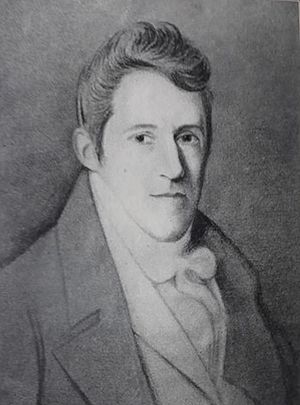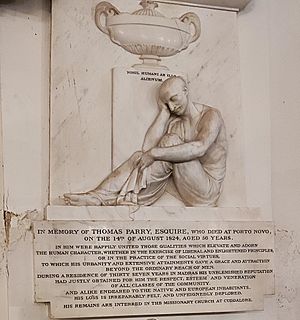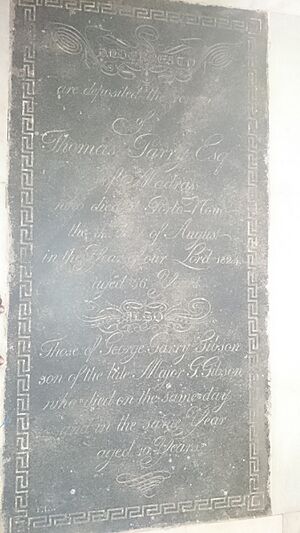Thomas Parry (Chennai merchant) facts for kids
Thomas Parry (born 1768 – died August 14, 1824) was a Welsh businessman who lived and worked in British India. He played a big part in starting a trading company in Madras, which is now called Chennai. In 1819, Parry teamed up with John William Dare to create a company called Parry & Dare. This company later became the famous EID Parry company. The building where his company was located gave its name to Parry's Corner, a well-known business area in Chennai today.
Contents
Early Life and Journey to India
Thomas Parry was born in 1768. He was the seventh child in his family. His parents were Edward Parry and Anne Vaughan, who lived at Leighton Hall, Powys in Wales. His family was quite wealthy.
When Thomas was only five years old, his father passed away. We don't know much about his early life after that. However, we do know that he sailed to India when he was 19 years old. He had family connections in Madras, which helped him get started. His cousin, Gilbert Ross Jr., was married to Thomas's sister. Gilbert's father, Gilbert Ross Sr., was a merchant in London. Thomas Parry likely learned about being a merchant from his uncle.
Thomas left England on March 4, 1788, and arrived in Madras on June 27, 1788. He was ready to start his new life and expand his family's business in India.
Starting His Business in India
Thomas Parry quickly got permission to work as a "Free Merchant" in Madras on February 12, 1789. This meant he could run his business without too many rules from the East India Company. He started his own business on July 17, 1788, selling different goods and offering banking services.
On November 1, 1789, he joined forces with Thomas Chase to form a new company called Chase and Parry. Thomas Parry also got involved in the leather business, even owning a tannery (a place where animal hides are made into leather).
In 1790, another partner, Henry Sewell, joined their company. This helped them earn more money, but it meant Parry's share of the profits became a bit smaller.
Building His Own Shipping Company
On January 1, 1792, Thomas Parry decided to start his own shipping business. This business grew quickly, partly because of the actions of Lord Cornwallis, a British general, who was fighting against Tipu Sultan at the time.
In 1794, Parry married Mary Pearce. She was a widow and already had a daughter. Thomas and Mary had a daughter named Eliza and a son named John, but sadly, both children died young.
Parry tried to start a newspaper in 1794, but the government did not allow it. In 1795, he began trading under the name Thomas Parry & Co. Around 1797, his company was known as Parry, Garrow and Co. because he had a partner named George Garrow. He also became a secretary for an insurance company.
Challenges and New Partnerships
In 1796, Thomas Parry bought land and built a large house called Parry's Castle. Today, it's known as Leith Castle. He also started working for the Nawab Omdat-ul-Omrah, a local ruler, earning a good salary.
However, his connection to the Nawab caused problems with the British officials at Fort St. George. In 1800, they told him he would no longer be protected and had to return to Britain. Parry tried to appeal this decision. In 1801, his partner Garrow left, and John King Lane joined as a new partner, forming Parry and Lane. They set up their office in George Town.
In 1805, the order for him to leave was canceled, and he continued his business. He even started another tannery. When his partner Lane left, Parry formed a new company called Parry Neill & Co. with John Neill and A. T. Gibbons. They mainly did business with the navy in Ceylon (now Sri Lanka).
Parry faced a big loss when a ship he owned shares in, the Marquis Wellesley, caught fire. He then decided to move away from shipping and started to focus on growing indigo (a plant used to make blue dye) and later sugarcane and tea. He also tried trading with Southeast Asia, but this also led to more losses.
Health Issues and Later Partnerships
In 1806, Parry and his family went to England because of poor health. While there, he got smallpox but recovered. In 1808, his partnership with John Neill ended. In 1809, his nephew David Pugh joined him, and they formed Parry and Pugh.
In 1810, J. W. Dare joined Parry as a partner. Parry and Dare bought a ship called General Palmer in 1819. In 1813, Parry started another partnership called Parry, Pugh & Breithaupt, which became very successful. In 1824, his friends in Madras gave him a gold cup to show how much they appreciated his work.
Death
Thomas Parry died from cholera in August 1824. He was visiting his indigo farms when he passed away. A young relative, George Parry Gibson, also died from cholera at the same time.
Parry was buried in Porto Novo, India, at the C.S.I. Christ Church. In his will, he made sure that his servants and a blind woman he cared for would receive monthly payments.
See also
- EID Parry




